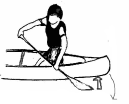Using Tandem Canoe Pivot Turns
Often the river currents will push your canoe towards obstacles such as strainers, undercut walls, falls, holes, boulders and rocky shorelines. The fastest way to change your location on the river and loosing the least amount of distance downstream is by using pivots and power strokes.
The Strokes
We will assume that both the bow person and the stern person are using correct form and are paddling on opposite sides of the canoe. Depending on which direction the paddlers want to pivot their canoe the bow paddler will either execute a bow or a cross bow draw and the stern paddler will use either a stern pry or a stern draw. The combination of strokes used by the bow and stern paddlers will determine whether the canoe pivots clockwise, counterclockwise or sideslips to the left or right.

Rotating the canoe clockwise using the bow draw and stern draw. Cross-bow Draw: Rotates the canoe counter clockwise. Stern Pry: Turns the canoe counter clockwise.

Pivot Clockwise: Bow paddler executing a bow draw. Stern paddler executing a stern draw.

Stern Draw: Turns canoe clockwise.
Application
Lets assume that the bow paddler is paddling right and the stern person is paddling left. The scenario is that it is imperative to move the canoe to the right to miss a down stream obstacle. A Pivot to the right would be needed to get the canoe turned until it is perpendicular to the river right shore.
To do this the stern paddler would use a stern draw and the bow paddler would use a bow draw. Both strokes would cause the canoe to pivot clockwise. Now that the canoe is positioned power strokes and good rudders will take the canoe swiftly toward river right.
Once the canoe has traveled far enough to river right to avoid the downstream object it needs to be pivoted so that it is once again facing down stream. To do this a pivot to the left would be needed. The bow person doing a crossbow draw and the stern person doing a stern pry does that. If executed with efficient strokes very little travel down stream will have occurred before getting the canoe in the desired position on the river. This technique works even with loaded 17 foot river expedition canoes.
Other Uses of Pivot Turns and Strokes
Common uses of the pivot are to set up river expedition canoes for eddy turns and to move the canoe from the outside of a bend in the river towards the inside where the rivers current is less. If you use the bow and stern pivot strokes in different combinations you can side slip the canoe to the left or right. This is useful when you want to move the canoe out of the back of an eddy to the eddy line to start an upstream ferry.
In a Tandem Canoe
If you need to get river right quickly. Pivot your canoe to the right. Pivot until you are perpendicular to the current and your bow is 90 degrees to the river right shoreline. Once this is accomplished use power strokes to move the canoe towards river right. When positioned where you want to is pivot left until your canoe is facing down stream. It is surpassing how quickly a bow and stern paddler working together can pivot even a loaded 17' canoe using the correct strokes.
Douglas Wipper, a former director of the National Canoeing Schools of Canada, is the director of the Steamboat Springs Canoeing School in Steamboat Springs, Colorado. He has instructed canoeing for universities and private camps for more than 30 years.
Related Articles
Engaging your core muscles while stand up paddling allows you to paddle more efficiently for longer…
One of the great things about kayaking is that on the very simple level you can just slip on a life…
Hey, sometimes you just don't want to go straight! Sweeps are used for turning and as a component stroke…
One of the negative aspects of canoe tripping is that you're forced to spend time in cramped quarters…


